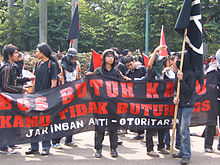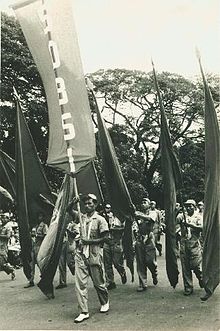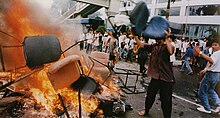Anarchism in Indonesia

| Part of a series on |
| Anarchism |
|---|
 |
Anarchism in Indonesia has its roots in the anti-colonial struggle against the
History
Dutch East Indies

The first evidence of anarchism in the Dutch East Indies was present in the
The organized anarchist movement
Dutch
Indonesian
After the war ended in 1918, anarchist groups began to grow larger, publishing newspapers with a broad reach throughout the country. Liu Shixin formed the "Society of Truth" group to distribute anarchist propaganda throughout the archipelago,[13] publishing the Soematra Po,[14][6] in Medan.[15] but eventually Liu's activity came to the attention of the police, who arrested the group in March 1919,[16] labelling Liu and his comrades "Bushiwei".[17] Liu Shixin was subsequently deported to China, for his role in propagating anarcho-communist propaganda.[15] In April 1919, the Workers' Union was established by anarchists in Surabaya, growing to include branches in other cities.[18] The Union published the anarcho-communist publication Zhenli Bao in Semarang, edited by Bai Binzhou and Wang Yuting.[19] In September 1919, Binzhou and Yuting were both arrested and deported to Hong Kong.[19]
Throughout the 1920s, anarchist organizations organized plantation workers, with attacks against Dutch administrators coming alongside,
The League against Imperialism

Indonesian students that were studying in the
Japanese occupation
The
The Indonesian National Revolution

Two days after the
The SOBSI and Guided Democracy
The workers' movement was subsequently reorganized, largely into the
With the introduction of
Contemporary Indonesia

The anarchist movement re-emerged in the 1990s as part of the Indonesian
For most of the early 2000s, the Indonesian anarchist movement remained dispersed and disconnected, with many of its groups being small and short-lived. This began to change with the organization of the 2007 May Day demonstrations, when various groups from around the country unified to form the Anti-authoritarian Network, gathering over 100 people in a May Day action, marking the anarchist movement's first large-scale appearance on the public stage and igniting an acceleration of the movement's growth.[48] The next May Day demonstration in 2008 attracted more than 200 people to protest in Jakarta, directing their action against corporate and political buildings in the city. The procession ended after clashes with police saw the arrest of many of the protest's participants. Although this repression brought a brief halt to the movement's growth, anarchist activists continued their agitation, so that by 2010 there were anarchists groups in Java, Sumatra, Kalimantan, Sulawesi and Bali.[48]
In 2011, a series of attacks against corporate buildings and ATMs in Sulawesi, Java and Sumatra were claimed by an Indonesian section of the Informal Anarchist Federation, bringing the tactics of insurrectionary anarchism to the country. The cell condemned peaceful protest, instead inciting direct action, often in the form of property destruction. Inspired by the actions, two anarchists Billy Augustian and Reyhard Rumbayan attacked an ATM in Yogyakarta, but were both quickly arrested after dropping incriminating evidence near the scene. Other insurrectionary anarchists of the "Long Live Luciano Tortuga" Cell in Sulawesi responded to their imprisonment with a series of attacks, including incendiary attacks on power stations and luxury cars. Further attacks from other FAI cells around Indonesia followed.[50]
The continuation of May Day events into the 2010s brought about a growth of interest in
In 2020, the government of Indonesia initiated a crackdown on anarchist activity, during which social media accounts were hacked, anarchist activists were arrested, books were seized, detainees were isolated. Police claimed that anarchists were planning a campaign of mass looting[56][57] and forced a confession from a criminal in which he declared himself "the sole leader of the anarchists."[58] In what many Indonesian anarchists have described as a "witch hunt",[59][60] on 9 April, three anarchists from Tangerang were arrested for spraying graffiti that read "there's a crisis already, time to burn" and "fight or perish",[56][57] being charged with public provocation.[61] The detainees were tortured by the police and were put into isolation for a month, before their trial began on 15 June.[62] The Tangerang District Court found the defendants guilty on 28 September, sentencing two to 10 months in prison and the other to 8 months, in what the defense considered to be a dangerous precedent.[63] Anarchists were also reportedly among the active participants in the protests against the passage of the Omnibus Law on Job Creation, during which militants set fire to police stations, vandalized property and clashed with police on barricades in a number of Indonesian cities.[64] In a press conference, police announced they were investigating 6 protestors who they claimed were affiliated with the anarchist movement.[65]
See also
References
- ^ Welcker, Johanna M. (1992). "Eduard Douwes Dekker" (in Dutch). No. 5. Biografisch Woordenboek van het Socialisme en de Arbeiderbeweging in Nederland. pp. 45–58. Archived from the original on 9 February 2021. Retrieved 23 September 2002.
- OCLC 182732078.
- OCLC 953665212.
- ^ Hoekman, Piet (1995). "Dirk Lodewijk Willem van Mierop". No. 6. Biografisch Woordenboek van het Socialisme en de Arbeiderbeweging in Nederland. pp. 142–147.
- OCLC 1235889073.
- ^ OCLC 1162616054.
- OCLC 953665212.
- ^ "南洋無政府主義運動之概況" (in Chinese). Vol. 2, no. 1. Minsheng. 25 January 1927. Archived from the original on 13 April 2012.
- OCLC 470386540.
- OCLC 470386540.
- OCLC 470386540.
- OCLC 470386540.
- OCLC 16226969.
- )
- ^ OCLC 1112676175.
- OCLC 769870825.
- ^ Wuzhengfu zhui sixian ziliao xuan. Vol. 2. Beijing. 1984. p. 935.
{{cite book}}: CS1 maint: location missing publisher (link) - ^ OCLC 769893159.
- ^ OCLC 1112676175.
- OCLC 1046338477.
- ^ Yugo-Vostochnaya Aziya: ocherki ekonomiki i istorii. Moscow. 1958. p. 157.
{{cite book}}: CS1 maint: location missing publisher (link) - ^ OCLC 1112676175.
- OCLC 943698312.
- OCLC 562345712.
- ^ OCLC 6899857194.
- OCLC 1164781033.
- ^ Müller-Lehning, Arthur (April 1929). "Der soziale und nationale Befreiungskampf Indonesiens" (in German). No. 6. Die Internationale. pp. 15–17.
- ^ De Ligt, Bart (October 1929). "Die wesentliche Einheit des Kampfes gegen soziale Unterdrückung mit dem Kampfe gegen Militarismus und Krieg" (in German). No. 12. Die Internationale. pp. 1–6.
- ISBN 978-0-582-71046-7.
- (PDF) from the original on 9 February 2021, retrieved 7 February 2021
- ISBN 978-0-521-54262-3.
- OCLC 474220066.
- )
- OCLC 1198929073. Archivedfrom the original on 9 February 2021. Retrieved 7 February 2021.
- OCLC 1198929073.
- OCLC 1198929073.
- OCLC 1198929073. Archivedfrom the original on 9 February 2021. Retrieved 7 February 2021.
- OCLC 1198929073.
- OCLC 1198929073.
- OCLC 422002504.
- OCLC 422002504.
- OCLC 1198929073.
- OCLC 1048427994.
- OCLC 255106977.
- OCLC 255106977.
- S2CID 194542403.
- from the original on 9 February 2021. Retrieved 6 February 2021.
- ^ )
- OCLC 181645375.
- ^ Berger, Dominic (12 October 2013). "Indonesia's new anarchists". No. 113. Inside Indonesia. Archived from the original on 9 February 2021. Retrieved 7 February 2021.
- ^ Workers' Power Syndicate (29 September 2012). "Indonesian syndicalists fight for justice at PT Garmindo Jaya KNH". Bogor: libcom.org. Archived from the original on 9 February 2021. Retrieved 6 February 2021.
- ^ Sprague, Ted (2 October 2012). "Indonesia: First general strike in 50 years". In Defence of Marxism. International Marxist Tendency. Archived from the original on 9 February 2021. Retrieved 6 February 2021.
- ^ Anarcho-Syndicalist Worker's Fraternity (2018). "Persaudaraan Pekerja Anarko Sindikalis". Jakarta: Radical Guide. Archived from the original on 9 February 2021. Retrieved 6 February 2021.
- ^ "Uber drivers strike in Indonesia". libcom.org. 23 August 2017. Archived from the original on 9 February 2021. Retrieved 6 February 2021.
- IWA-AIT. Archivedfrom the original on 9 February 2021. Retrieved 6 February 2021.
- ^ a b Soeriaatmadja, Wahyudi (12 April 2020). "Coronavirus: Police arrest five Indonesians attempting to instigate looting". The Straits Times. Archived from the original on 9 February 2021. Retrieved 6 February 2021.
- ^ a b Oktavianti, Tri Indah (14 April 2020). "Books seized, five arrested as police claim anarcho-syndicalists plan mass looting in Java". The Jakarta Post. Archived from the original on 9 February 2021. Retrieved 6 February 2021.
- ^ Safehouse Infoshop; Local Autonomous Network (6 May 2020). "In Solidarity With Comrades Imprisoned in Malang and Tangerang, Indonesia". Bandilang Itim. Archived from the original on 9 February 2021. Retrieved 6 February 2021.
- ^ The Individualist Circle (12 April 2020). "About the Indonesian Anarchist Witch Hunt and the "Normal Activist Mentality"". Anarchists Worldwide. Archived from the original on 9 February 2021. Retrieved 6 February 2021.
- ^ Circle of Marvelous Individualists (23 April 2020). "The Continual Anarchist Witch Hunt & the Scenario of State Incompetence". Anarchists Worldwide. Archived from the original on 9 February 2021. Retrieved 6 February 2021.
- ^ Anti Feminist Feminist Club (29 June 2020). "Solidarity with Anarchist Prisoners in Tangerang and Bekasi in Indonesia". Bandilang Itim. Archived from the original on 9 February 2021. Retrieved 6 February 2021.
- ^ Anti-authoritarian Federation (25 July 2020). "Update on Anti-Authoritarian Prisoners Involved in Vandalism (Tangerang and Bekasi, Indonesia)". Bandilang Itim. Archived from the original on 9 February 2021. Retrieved 6 February 2021.
- ^ Anti-authoritarian Federation (13 October 2020). "The Tangerang Vandalism Case: The Court Decides Guilt Despite Torture and Inappropriate Application of Articles". Bandilang Itim. Archived from the original on 9 February 2021. Retrieved 7 February 2021.
- ^ "Police Posts Torched in Uprising against Omnibus Law in Indonesia". Abolition Media Worldwide. 10 October 2020. Retrieved 22 July 2021.
- ^ "New Crackdown on Anarchists Following Anti-Omnibus Law Protests". Anarchists Worldwide. West Java. 15 August 2020. Retrieved 22 July 2021.
Further reading
- Estrelita, Gloria Truly; Donaghey, Jim; Facal, Gabriel (December 19, 2022). "A Brief History of Anarchism in Indonesia". Anarchist Studies. Retrieved December 26, 2022.
External links
- PPAS website
- Indonesia section - The Anarchist Library
- Indonesia section - Libcom.org
